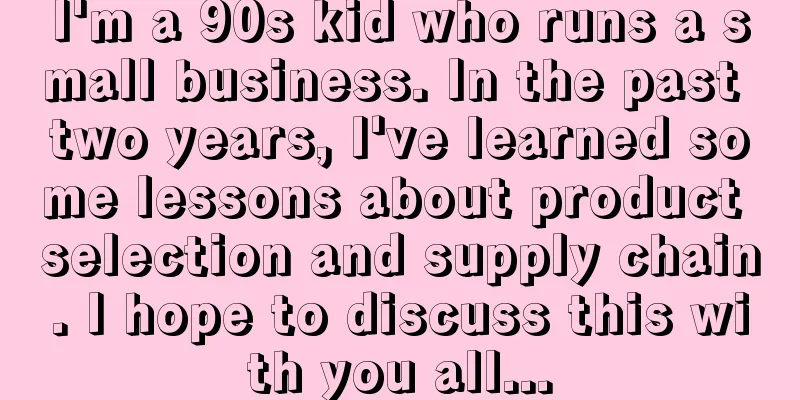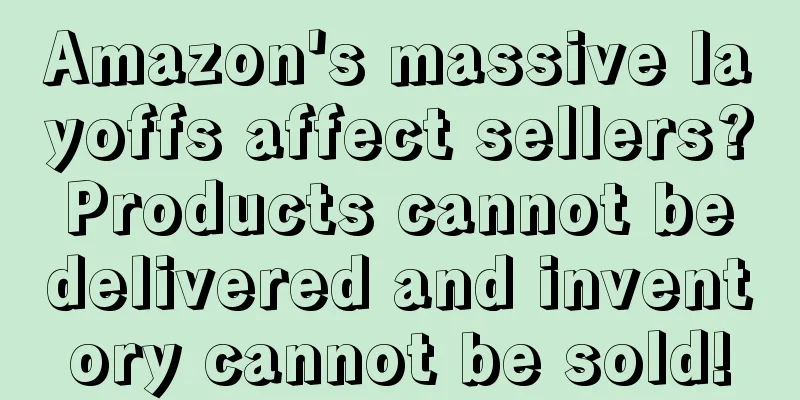I'm a 90s kid who runs a small business. In the past two years, I've learned some lessons about product selection and supply chain. I hope to discuss this with you all...

|
1. Product selection considerations: The market changes too fast, so try to find products away from Amazon. The market changes too fast. If you find a product you think you can make on Amazon, others will also see it. The speed of copying is too fast. Without any advantages, it is easy to be washed away by the previous wave. And some products with a large market volume will also be rushed in by the next wave if they sell well. Therefore, we try to go deep into a certain category and look for products on enthusiasts' websites. For example, in the maternal and child category, I will look for opportunities on Etsy and baby-related forums. If the sales are good or the discussion is high, it can become our inspiration library for product selection. Use social media search engines to find products Now that various platforms are flourishing, everyone must have a [link] mindset. In the past two years, the operation of independent websites using social media has been very popular, and I think it is also advantageous for us to find products. When we go deep into a certain category and enter keywords on the corresponding social media website, some slots of the corresponding category will pop up, as well as solution products launched by many brands in large quantities. These products have been verified by some social media data, so it will be much easier to imitate and enter the Amazon market. Use social media to find products This is an extension of finding products on social media. We should develop good habits of watching videos, train our social media into our own product finding tools, and let social media focus on the product side. ①Find products that solve specific problems. I will stay longer on products that solve a single pain point. If it is related to my category, I will look at their update date and number of followers. The update date determines whether the product is popular recently and how long it has been popular. Generally, we will choose products that are popular recently, so that we can speed up the imitation and gain a certain market share on Amazon. Instead, I look at their number of followers. If the number of followers is too high, more than hundreds of thousands, I will wonder why the data is so good, but no one imitates it. There must be some reasons that I don’t know. ② Look at the products promoted by Amazon categories. There are often "AMAZON XXXX HACK" on the video push of ins. There are many product inspirations in this kind of promotional videos. Although they promote Amazon products, you can find a lot of inspiration in the comment area. ③ Look at aesthetically pleasing products. Many products in the maternal and infant category that I work in require aesthetic coordination. So we need to accumulate aesthetic materials. Off topic, if you look at the slogan of the domestic brand Babycare: Redesign for love, you should know the importance of aesthetics. ④ To see the products that are used most by American families, you can read the jokes of local people and see the products they need in their daily lives. ⑤ Going deep into the nodes is the prerequisite. Everything must be understood about the product nodes and start with interest. At the same time, after finding the product, build an inspiration library and find ways to make and sell what you see. Observe competitors and benchmarks, and use the 4P model to observe competitors. Consider and observe competitors from several aspects, namely product, price, promotion, and place. Strengthen the design. Visual design is the simplest way to differentiate your product. You can work with a visual designer. 2. Supply Chain Thinking How to negotiate with factories First, determine the requirements, including size, color, etc. Then start a large-scale search, go to 1688 and other supply platforms, consult online MOQ, whether there is a public mold, how much is the price, can I take a public mold first to see. Secondly, select three factories, and then call to inquire whether there have been inquiries before, how is the sales volume, etc. The phone can close the distance with the supplier and understand the industry information more clearly. Then ask about the delivery time, packaging, including packaging method, size, box specification, whether the thrown goods can be compressed, etc. Procedure after receiving the sample After getting the samples, ask the supplier to issue a cost accounting sheet. To be honest, they don’t know how to write one, but if one does, you can get a good idea of the cost. Then ask for two sets of pre-production samples, indicating the details (including labeling, packaging, box specifications, etc.) Sample process sheet. After proofing, I often receive a situation where the sample is different from the proofed product, so a more detailed process sheet is very necessary. Therefore, the first question is: How do we write a supply order and how do we ensure that the sample is consistent with the bulk product? During the proofing process, you can give priority to packaging issues and put them in the front. I have suffered from not considering packaging before, which caused delivery delays. Moreover, many sellers now work hard on packaging in order to reflect the visual difference on the homepage, so there must be no problem with the front packaging design. A better way is to inspect the factory before shipping large quantities of goods, but to be honest, it is meaningless for small sellers to inspect the factory without large quantities. Preparation before replenishment. Everything including care labels, tags, and codes must be prepared in advance, and the quantity of materials provided to the supplier must be recorded one by one. 3. Efficiency Thinking It's hard to work alone, especially when there's no output. So you need to have both financial and mental support to keep going. Be sure to set a deadline for yourself and set a submission time. In the actual process of starting a business, the supply chain will delay your time, the art department will delay your time, and the logistics will delay your time. Therefore, you have to rush and do it yourself. Try to reply to various messages as soon as possible , and don't extend the progress of a project. Not only in terms of execution, but also in terms of thinking, we must maintain the consistency of thinking and think about the uniqueness of our business. ” – provide people with something they need and can’t get, and do it at scale. Allocate time wisely My advantage is finding products, so I should magnify my advantage and spend my time on my strengths. Act-Think-Change This is my code of action this year. I learn a lot every year, but without feedback and records, without thinking and summarizing, it ends up being just talk. I need to constantly review my problems, take action, think again, and change. Make good use of tools. Doing business is also a process of continuous learning. Working alone requires continuous learning. Reasonable use of weareseller chatGPT and other AI technologies can help us who work alone. Weareseller finds peers to solve problems together and sees the ideas of experts. Use chatGPT for brainstorming and use Midjourney to make design demos. You really can’t enjoy yourself too much when doing e-commerce. You have to constantly select products and get in touch with new products and new factories, and you have to constantly expand your understanding of the industry in your own category, only then can you go further. This leads to the second question of today. Which big names do you follow on Weareseller, and how do you conduct self-study on AMZ in your daily life? To sum up, the above is my thinking about the efficiency of product selection supply chain, which leads to two questions: 1. How do you write a sample process sheet? 2. Which amz big names do you follow on the platform, and how do you usually conduct self-study on amz? |
Recommend
Etsy releases "Images of Minors" policy! Officially implemented on September 8th!
According to foreign media reports, Etsy will impl...
What is U-Link? U-Link Review
U-Link is an advertising product displayed on coop...
What is OnBuy? OnBuy Review
OnBuy is an online retail marketplace that was off...
Yitu Technology CTO Yan Shuicheng is reported to have resigned and may join Southeast Asian e-commerce company Shopee
Yitu Technology CTO Yan Shuicheng has resigned and...
What is Ant Store Manager? Ant Store Manager Review
"Ant Store Manager "MAEE" is a SaaS...
What is Marketplace Pulse? Marketplace Pulse Review
Marketplace Pulse is an e-commerce data company th...
What is Kinja Deals? Kinja Deals Review
Kinja is the Deal section of Gawker, the largest c...
More than 100,000 children's products were recalled! Involving Amazon, Walmart and other platforms!
It is learned that according to foreign media repo...
What is Onlypult? Onlypult Review
Onlypult is an Instagram management tool that can ...
The proliferation of counterfeit goods undermines market fairness, and sellers jointly demand Etsy to rectify
It is learned that on February 23, after being acc...
US baby products sales cool down! 5 hot trends predicted for 2023
According to data from the NPD Group, retail sales...
How to Create the Best Amazon Product Titles (One-Minute Analysis)
How to write product titles accurately is not just...
What is Paytren? Paytren Review
Paytren, an Indonesian payment platform, is a mobi...
What is Wanfang Network? Wanfang Network Review
Shenzhen Wanfang Network Co., Ltd. is a cross-bord...
Amazon Black Friday "crash" alarm sounded! Problems frequently!
Black Friday is over, but Amazon sellers are still...









